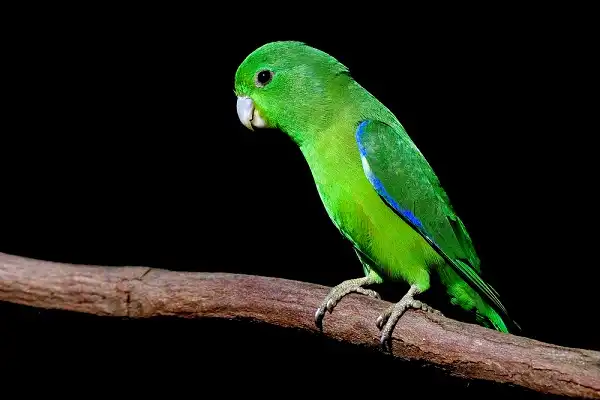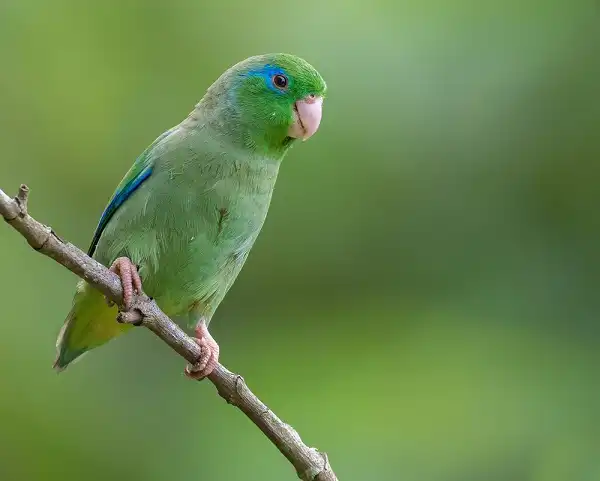Are you looking for a pet that is both low maintenance and full of personality? If so, the spunky Parrotlet may be the perfect companion for you! These miniature parrots are an increasingly popular choice among bird enthusiasts. Their attractive coloring and inquisitive nature make them enjoyable additions to any home or office. Not only can they speak a few simple words or phrases, but they also have unique personalities that will keep your family entertained while providing companionship. Read on to learn more about these fascinating little birds – from their history and diet needs to tips on how best to care for them.

Parrotlet Description
Parrotlets are small, robust parrots that are native to Central and South America. There are several species of Parrotlets, with the most common being the Pacific Parrotlet and the Green-rumped Parrotlet. Parrotlets are incredibly active and inquisitive birds, making them a joy to watch and interact with. They have a curious and playful nature and love to explore their surroundings. Despite their small size, they have big personalities and are known to be quite outgoing and affectionate toward their owners. In terms of appearance, Parrotlets come in an array of colors, including blue, green, yellow, and white. They have a stocky build and a short tail, with a peak-shaped beak that they use to crack seeds and fruit. They also have keen eyesight and can detect even the slightest movement.
Parrotlet Habitat
Parrotlets are native to Central and South America, where they inhabit a range of habitats including tropical forests, savannas, and scrublands. They are known to be adaptable birds and have successfully established feral populations in parts of the United States, particularly in the warmer states of California, Texas, and Florida. In the wild, Parrotlets are social birds that live in small flocks, and they are often seen foraging for food in the treetops. Their habitats typically consist of a variety of vegetation types, including tall trees, bushes, and grasses. They also require access to a water source such as a river, stream, or waterhole. In captivity, it is essential to provide Parrotlets with a habitat that meets their physical and behavioral needs. They require a cage that is spacious enough for them to fly around in, with plenty of perches and toys to keep them mentally stimulated. The cage should also be placed in a quiet area of the home, away from any potential stressors such as loud noises or predators.
Parrotlet Diet
Parrotlets are primarily seed-eaters in the wild, but their diet is also supplemented with fruits, berries, and vegetation. In captivity, it is essential to provide a varied diet that includes commercially-bought parrot seed mix, small portions of fresh fruits like apples, berries, and bananas, as well as fresh veggies like carrots, broccoli, and spinach. Calcium-rich foods like cuttlebone, mineral blocks, and vitamin supplements should also be given occasionally. One of the most significant concerns regarding Parrotlets’ diet is nutrition deficiency, which can lead to several health problems like feather-plucking, obesity, and heart diseases. A balanced diet with all the essential nutrients, including vitamins and minerals, is crucial to maintaining their health and well-being.
Owners should do research on their diet and consult a vet to ensure that the bird’s nutritional needs are met. Another crucial aspect of the Parrotlet’s diet is the timing and frequency of feeding. These birds are voracious eaters and tend to overeat when food is plentiful, leading to obesity and related health issues. Therefore, it is recommended to provide small and frequent meals and limit the quantity of food. A general rule of thumb is to provide around two to three teaspoons of food per day and remove any uneaten food promptly. For water, Parrotlets require fresh, clean water available at all times. The water container should be rinsed and cleaned daily to prevent the growth of bacteria.

Parrotlet Size
Parrotlets are one of the smallest parrot species, measuring only about 4-5 inches in length on average. They have a plump and compact body structure and weigh between 28-40 grams, depending on their age and gender. Males are typically larger than females and have a more robust build. Despite their small size, Parrotlets have impressive flying abilities and can fly at high speeds and perform acrobatic feats in the air. They have strong wings and can cover long distances, making them highly adaptable to a variety of environments. Parrotlets may be small in size, but their remarkable physical abilities, striking appearance, and impressive lifespan make them fascinating species to observe and care for. Understanding their physical characteristics and needs is crucial to providing them with a safe and healthy living environment.
Parrotlet Lifespan
Parrotlets are a species of parrot known for their small size and striking appearance. Despite their small size, Parrotlets have impressive flying abilities and can fly at high speeds and perform acrobatic feats in the air. They have strong wings and can cover long distances, making them highly adaptable to a variety of environments. In terms of their lifespan, Parrotlets can live up to 15-20 years in captivity with proper care and attention. However, in the wild, their lifespan is generally shorter and can range from 5-10 years due to various external factors such as predators, food availability, and habitat destruction. To ensure a long and healthy life for a pet Parrotlet, owners need to provide them with a safe and healthy living environment. This includes proper nutrition and hydration, regular exercise, and adequate social interaction.
Parrotlet Behavior
Parrotlets are a fascinating species of birds not only due to their striking appearance and impressive lifespan but also because of their unique behaviors. Parrotlets are highly social creatures and thrive on interaction with their human companions. They are known for their active and playful personalities, which make them delightful pets. Parrotlets are intelligent and curious birds that require mental stimulation to keep them healthy and happy. They have a complex, rich, and ever-changing vocal communication system, which they use to communicate with their flock members and their human companions. They can mimic a variety of sounds, including words and phrases, and use them to express their emotions or convey messages.
Parrotlets are also known for their playful behavior. They love to explore their environment, play with toys or objects, and engage in various playful activities. They are particularly fond of puzzles and games that challenge their intelligence and problem-solving skills. Owners can develop a strong bond with their Parrotlets by actively engaging them in interactive and playful activities. Parrotlets are also territorial birds and can become aggressive towards other birds or humans if they feel threatened or insecure. Owners should socialize their Parrotlets from an early age and provide them with plenty of positive reinforcement to build their confidence and trust.

Parrotlet Speed
Parrotlets are known for their impressive flying abilities, and speed is no exception. They are incredibly fast and agile birds that can reach speeds of up to 30 miles per hour in flight. This makes them one of the fastest small parrot species in the world. Parrotlets have a unique wing structure that enables them to fly with unparalleled speed and precision. Their wings are short, broad, and somewhat pointed, giving them excellent maneuverability and lift. They also have a high wing loading, which means they can generate a lot of lift with a relatively small wing area, making them highly efficient fliers.
Parrotlets are also capable of quick and precise movements in flight, making them adept at dodging obstacles and predators. They have excellent eyesight, which enables them to spot potential dangers from a distance and react quickly. In addition to their impressive flight abilities, Parrotlets are also known for their incredible agility on the ground. They are highly active birds that enjoy climbing, jumping, and running. They use their powerful legs and feet to grip surfaces and propel themselves with impressive speed and agility.
Parrotlet Hunting
Despite their small size, Parrotlets are fierce hunters in the wild. They use their impressive speed and agility to catch insects, small birds, and even mammals like mice and bats. Their sharp beaks and claws allow them to easily tear apart their prey and extract the nutritious meat. Parrotlets have excellent eyesight, which helps them spot their prey from a distance. They also have remarkable hearing and can detect the subtle movements of their prey in the surrounding environment. Once they locate their target, Parrotlets use their incredible speed to swoop down and capture it in their sharp talons. In addition to their hunting skills, Parrotlets are also known for their ability to blend into their surroundings. They have a natural camouflage that allows them to sneak up on their prey undetected. Their green and blue feathers with black and white markings make them blend seamlessly into the lush foliage of their forested habitat.
Parrotlet Training and Care
Parrotlets require a great deal of care from their owners. They need a lot of attention and stimulation, so providing them with toys and activities is essential for their mental health. Parrotlets are also very intelligent birds and can be trained to do simple tricks like sitting on your finger or speaking short phrases. Training should always be done in a positive and encouraging manner as Parrotlets easily become stressed out by negative reinforcement. In addition to training, Parrotlets need plenty of fresh food, clean water, and a spacious cage that allows them to move around freely. It’s important to provide them with natural branches they can climb on and chew on as well as bird baths so they can preen their feathers. With the right environment and care, Parrotlets can make wonderful companions for years to come.
Parrotlet Common Health Issues
Parrotlets can suffer from several common health issues, including feather plucking, vitamin deficiencies, respiratory infections, and parasites. It’s important to inspect your Parrotlet regularly for any signs of illness or injury and take them to a veterinarian if they are showing signs of distress. A proper diet is also essential to maintain the health of your Parrotlet; make sure they have access to fresh fruits and vegetables as well as a high-quality seed mix. Additionally, ensure that their cage is clean and free from parasites or other contaminants. With the right environment and care, Parrotlets can live long and happy lives with their owners.

Parrotlet Types
There are several species of Parrotlets, including Pacific Parrotlets, Spectacled Parrotlets, Green Rumped Parrotlets, Mexican Parrotlets, and Yellow Shouldered Amazon Parakeets. While each species have unique physical characteristics and behaviors, they all require a great deal of care from their owners. It’s important to research the particular needs of the species you plan on keeping before bringing them home. Additionally, it’s important to be aware of common health issues that can affect your parrotlet as well as providing them with proper nutrition and an environment that allows them to move around freely. With the right care and attention, your parrotlet will make a wonderful companion for many years to come.
Conclusion
Parrotlets are highly active, intelligent parrots with remarkable speed and agility. Their unique wing structure and high wing loading enables them to fly at incredible speeds and make quick and precise movements in flight. On the ground, their powerful legs and feet allow them to climb, jump, run, and swim with remarkable speed and agility. In the wild, they use these abilities to hunt for insects, small birds, and even mammals like mice and bats. Parrotlets also have excellent eyesight, hearing, and camouflage that helps them sneak up on their prey undetected. In captivity, their natural hunting instincts remain intact despite not needing to hunt for food. Overall, Parrotlets are fascinating creatures requiring a great deal of care from their owners.
Frequently Asked Question


